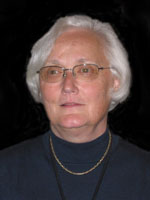
Barbara K. Vonderhaar
National Cancer Institute
Becoming a Player on the Field
The year 2006 marks not only the seventy-fifth anniversary of the Gordon Research
Conferences but also the thirty-fifth anniversary of the Mammary Gland Biology (MGB) Conference. My first GRC experience was in 1973 when, as a second-year postdoctoral fellow, I was asked to give a plenary talk at the second biennial MGB Conference. I had entered the field only two months after the conference’s first meeting, then called the Biology of Milk.
The MGB Conference has been a place where long-standing collaborations were formed and scientists grappled with fundamental issues in the field. The highly successful
Journal of Mammary Gland Biology and Neoplasia was founded over lunchtime discussions, and its editorial board now meets annually at the conference. It was at this conference that Kurt Ebner explained the newly discovered function of the old milk protein alpha-lactalbumin. Dale Bauman described his progress in the use of recombinant bovine growth hormone to increase the milk yield of dairy cows (setting off an international firestorm, not to mention giving agribusiness a multimillion-dollar boost). When Dolly was cloned from a mammary epithelial cell, we spent an entire afternoon sitting on the floor of the parlor in one of the Colby-Sawyer College dorms debating the scientific, societal, and ethical implications of this earth-shaking event. Creation of the first transgenic pig, in which the mammary gland was used as a bioreactor to express blood-clotting proteins in milk through directed expression to the mammary gland, was first described at the 1987 MGB Conference which I chaired.
At the first conference I attended, I was delighted to meet and interact with the stars of the field–senior investigators such as Ken DeOme, Ranu Nandi, Stu Patton, Bob Jenness, Jim Linzel, Howard Bern, Joel Elias, Cliff Welch, and Dorothy Pitelka. We “smart young things” who wanted to be players would spend the morning and evening sessions listening to the “great white heads,” as we called them. During the afternoons–on the tennis courts or while playing basketball, or late into the evening over drinks–we discussed the scientific insights they had shared with us. Today I am one of the “great white heads,” and although golf is now my game, discussing new insights over evening GRC sessions or afternoon recreation remains as thrilling as ever.
The evolution of the MGB Conference, as well as the GRC organization as a whole, reflects the changes I have seen in science and the mammary biology field over the last thirty-five years. At the 1973 conference I was one of only a handful of women on the program or in the audience. In 1987 I was only the second woman to be elected chair of the MGB Conference. This field has since exploded: recognition of the importance of the mammary gland as a biological system and as a source of food and energy, and the pervasiveness of breast cancer, have commanded extensive funding from public and private entities. Attendance at the MGB Conference steadily increased over the years until it became clear in 1999 that the community could support an annual meeting.
Because international attendance at this conference has always been high, the meeting now alternates between sites in the United States and in Europe. The conference is also vastly oversubscribed. Changes in demographics are equally important: today; at least 50 percent of the attendees at this conference are women, and five of the last ten chairs were female.
My sixteen-year involvement with GRC governance began in 1985 when I was first elected to a three-year term as an at-large member of the council. I then served six years on the Selection and Scheduling (S&S) Committee starting in 1989. I remember the first day of the 1989 S&S meeting at the York Harbor Inn in Maine, where once again I was only one of a few women in a sea of male faces. It was then that I first met Leila Diamond from the Wistar Institute, a legend in the cancer field. As the second woman to be elected to the board of trustees and an old hand at S&S, she took me under her wing. She and I became immediate friends and coconspirators. At the end of the fall 1990 S&S meeting, on one of our long walks along the rocky coast of Maine, she predicted that I would be elected to the board and one day serve as its chair.
I was only the fifth woman ever to be elected to the board, serving from 1995 to 2001, and only the second woman to become chair of the board, functioning as such for the 1998—1999 term. At our last meeting together in 1995, as I prepared to take her board seat, Leila and I talked about the culture of science and the lack of women scientists in prominent roles. We decided we would do something about it and that the GRC organization would be at the cutting edge of the issue. By the time I left the board, half of the twelve elected board members were women; since 2001 three more have served as board chairs. I believe that the Gordon Conferences and the entire scientific community have greatly benefited from this inclusion.
Over the past thirty-five years women have slowly advanced into the upper ranks of scientific society. The MGB Conference and the GRC organization as a whole have been at the cutting edge of this trend and stand as stellar examples of the inclusion of women in scientific pursuits for the rest of the community. I am proud to be associated with both.